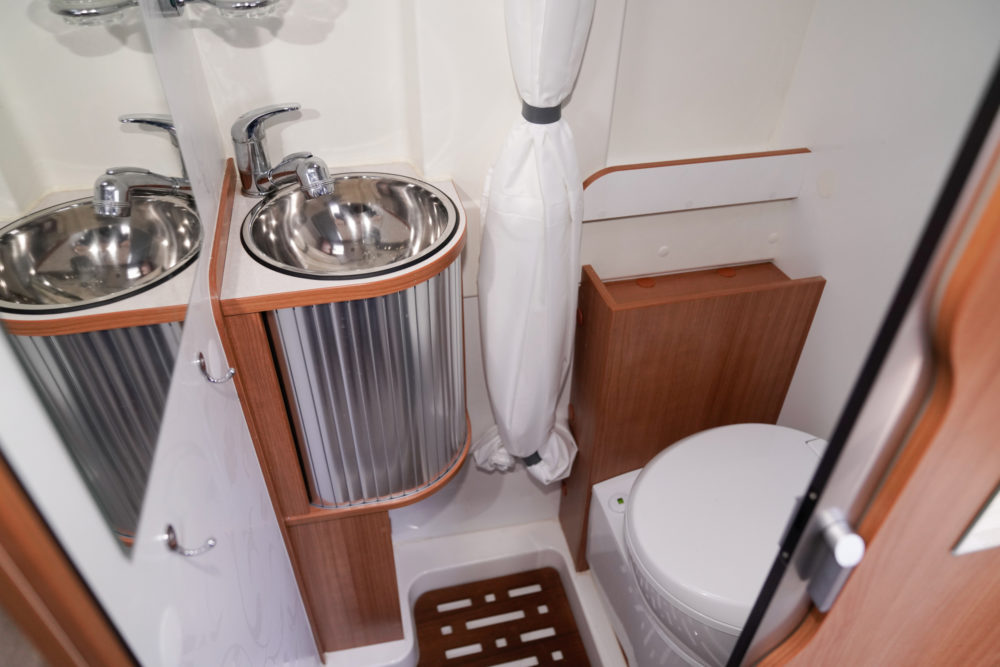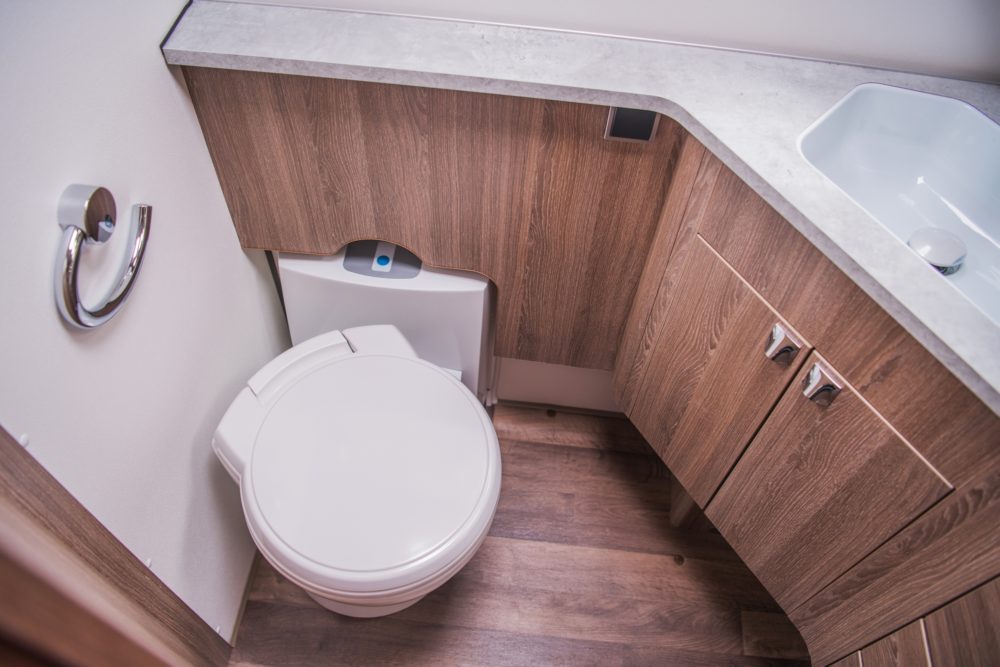Common Reasons Why Your RV Toilet Is Leaking
The RV toilet can leak for several reasons:
- Improper install
- Damage from travel
- Old/worn out seals
- Loose fittings
- Cracked valves
- Cracked bowl
- RV toilet flush pedal damaged
- Clog/backup

Contents
What To Do If Your RV Toilet Is Leaking?
When your RV toilet is leaking, the first step is to narrow down the source of the leak. Is the toilet filled with water? Is there water access to the lines? Is the leak only around the base of the toilet itself?
With evident “active” leaks that are either dripping or spraying from the damaged source, it is pretty simple to see the source of the leak, to mark it and to fix it. However, sometimes there’s only a puddle of water, because there’s no water pressure and the water might only leak during a specific action (such as, flushing the toilet, or travel).
When it comes to any RV leaks, water will travel toward the lowest point via the path of least resistance. Thus, once you determine where the water is pooling, you should be able to trace back the water path to the source of the leak.
Another way to narrow down the issue is to determine whether the leak comes from the top or the bottom of the toilet. A leak from the base of the toilet is most of the time a flange seal leak. A flange seal is the rubber wax ring that seals the underside of the toilet to the surrounding of the opening to the black tank.
A leaking toilet can become an emergency if it is a continuous fast stream of water (or even worse, includes a waste backflow), because it can damage your RV throughout. You want to make sure that you stop the water supply as soon as possible to stop the leak so that you can address the issue.
With a leak around the bottom of the toilet, the following steps are recommended:
- Buy a new flange seal that matches your toilet model.
- Shut off the water to the toilet.
- Flush the toilet to drain it.
- Remove the toilet from the floor.
- Replace the seal.
- Put the toilet back and turn the water back on.
You will need the following tools or parts:
- A replacement seal
- A wrench or socket set
- A putty knife
- Teflon tape
- Hand mirror
- Old towels
- Cleaning supplies
- Rubber gloves
(Source: https://lifeonroute.com/rv-toilet-leaking-around-base/)
With a cracked toilet, the steps are similar, except you replace the whole unit.
Common RV Toilet Problems (And How To Fix Them)
Problem #1: The RV toilet is leaking from the base.
Solution: As mentioned above, the likely culprit is a leaky seal that might be brittle or just worn out. Turn off the water, detach the toilet, replace the seal, re-attach the toilet and you should be good to go.
Problem #2: The RV toilet is leaking from the hose connection.
Solution: This could be either a pinhole leak (caused from frozen pipes, damage or other wear and tear), or it could be a leak from the actual connection. In either case, turn off the water supply, remove the hose assembly, test the hose for leaks and tape or replace the hose part. If it is the connector, replace the component and reassemble. Turn on the water to test your repairs.
Note: sometimes, the connections come loose during travel due to vibration and have to be simply re-tightened. Make sure not to overtighten.
Problem #3: The RV toilet is backing up.
Solution: You most likely have a clog, or a “poop tower/pyramid” (as it is lovingly referred to in RVer circles). With a clog and buildup, you will have to make sure you unclog the toilet first before addressing other potential issues.
Follow these steps to unclog your RV toilet:
- Close black tank valve
- Add water to the tank
- Pour a bottle of Holding Tank Cleaner into the tank
- Let the cleaner sit for 12-72 hours
- Open valve to empty the tank
- Rinse the tank
- Close the black tank valve
(Source: https://www.rvingknowhow.com/how-to-unclog-rv-toilet/)
You could try to use a toilet plunger to unclog the toilet, or pour ice cubes into the black tank right before your trip to the next RV park. There are also other different organic/biodegradable solutions, such as bio enzymes that help dissolve fecal matter and prevent “poop pyramid” buildups.
There are also higher-pressure wands one can build or purchase to insert into the black tank area to help dissolve some of the buildup. Another great build-up prevention is to flush twice after each bathroom visit, if possible.
Problem #4: The RV toilet is not holding water.
Solution: When this happens, it’s usually because a rubber seal called the blade seal no longer holds water and must be replaced. This requires disassembly of the toilet and replacement of the blade seal. If you are not comfortable doing this yourself, make sure you call a professional (such as a mobile RV tech).
However, there are step-by-step instructions in the manual and there are repair kits one can purchase. A new blase seal costs anywhere from $16-$30 at a local hardware store.
Problem #5: The RV toilet foot pedal valve is not working.
Solution: When the foot pedal that is used for flushing the RV toilet is not working, it is often that the flapper and the seal are sticking together. This can happen when one has not winterized the unit properly in the past.
You can get the two unstuck by pouring some water into the toilet and letting it sit for 30 minutes. If that doesn’t get the pedal unstuck, you can try to use a lubricating spray.
If neither of those solutions work, you might have to replace the foot pedal. However, some of the toilets do not have the ability to do that, and you will have to replace the whole toilet.
Problem #6: The RV toilet is leaking intermittently.
Solution: This is also likely caused by a seal failure under the toilet. You must remove the toilet and replace the seal to see whether this fixes the issue. If it only leaks when you use the foot pedal, review Problem #5.
Problem #7: The RV toilet valve is stuck in the open position.
Solution: This is a stinky and annoying problem. Sometimes, you can get the toilet valve unstuck by If needed, shut down the water supply. Remove the faulty valve and replace with a new, functioning one.

How Much Does It Cost To Fix An RV Toilet?
Any RV supply store, RV parts wholesaler or an RV dealership with a stocked-inventory service department carry replacement parts to repair an RV toilet. Of course, one can also purchase pretty much anything online, such as on Amazon or on https://www.campingworld.com. Some parts that are interchangeable with regular plumbing components can also be purchased at a local hardware store or a plumbing supply store.
Some of the regularly replaced items and their average cost are listed below:
The entire RV toilet: $89-$240
Toilet water valve kit: $18+
Toilet base: $88
Flush ball seal: $12+
Ball shaft cartridge kit:: $40+
Waste ball: $36+
Flush valve assembly: $38+
Tools needed for RV toilet replacement or repair:
- Screw driver
- Wrench
- Rags
- Old Towels & Newspaper
While some repairs are fairly easy and can be DIYed with help of YouTube, some might require professional help. In that case, one can either bring the RV to a local RV service center or call a mobile RV technician for faster and on-the-spot repairs (that cost a bit extra due to convenience).
The labor rate for an RV tech varies by state, difficulty of repair and the hourly business rate, but it ranges anywhere from $100-$250/hr.
If you do not feel comfortable making the repairs yourself or are stuck in the middle of nowhere, you can always use the National RV Training Academy (NRVTA) Locator on https://rvtaa.org/locate/ to locate a mobile RV tech in your area and get diagnostics and repairs right where you are.
Of course, there are DIYers who make the case that for the hourly labor rate of a technician you can easily replace the toilet (and assembly) yourself, and they provide extensive step-by-step videos to show how to do it (for example: https://rv-roadtrips.thefuntimesguide.com/rv_toilet/).
Either way, you should choose the route you are most comfortable with, because even if you decide to replace the toilet yourself following YouTube videos, the worst thing would be to have another leak that leads to extensive secondary damage.
How Long Should An RV Toilet Last?
On average, an RV toilet lasts about 10 years, depending on the plastic VS ceramic model. This varies greatly depending on one’s regular maintenance and average wear and tear/regular use.
Below are some maintenance tips that help you max out the RV toilet lifespan:
- Every time the toilet is removed, replace the seal
- Keep the flush seal moist (water) or add some vaseline when not in use to ensure longer life
- Do not use harsh cleaning chemicals or scrubbing
- Use only RV/marine toilet paper that’s water-dissolvable
- Use proper black tank chemicals
- Make sure the black tank has enough water/liquids to avoid buildup
(Source: https://www.rv.com/servicing-care/safety-maintenance/rv-toilet-maintenance/)
FAQs
Can you use a wax seal on an RV toilet?
Yes, you can and in fact, that’s what some RV toilets have when they are installed to seal the toilet to the black tank opening. Others use a rubber ring. The only disadvantage of a wax ring is that it can melt under high heat (such as RVing in Arizona in the summer).
Can you use Vaseline on an RV toilet seal?
Yes, if the RV toilet seal is a rubber seal, you can use Vaseline to keep it from cracking.
Are RV toilet flanges standard size?
When comparing RV toilets to standard household toilets, RV toilet flanges are different to regular toilets. Household toilet flanges can be 3” or 4” and utilize a wax donut ring as a seal. RV toilet flanges are generally 3” and use a rubber gasket as a seal (although there are some exceptions).
Are RV toilet seals universal?
Yes, most are universal and an easy replacement fix.
Do RV toilets have a warranty?
The Dometic brand of RV toilet has a 2-year warranty from the time of manufacture, assuming regular wear and tear use.
Can you replace an RV toilet with a regular toilet?
You cannot replace an RV toilet with a regular toilet due to the significant difference in plumbing, setup and installation. The mechanical differences are irreconcilable (e.g. flushing tank/mechanism etc.).
However, the RV industry has moved from a plastic RV toilet toward a ceramic RV toilet for many newer units. This helps with cleaning and overall ease of use and durability. However, these toilets still have a foot pedal flushing mechanism.




